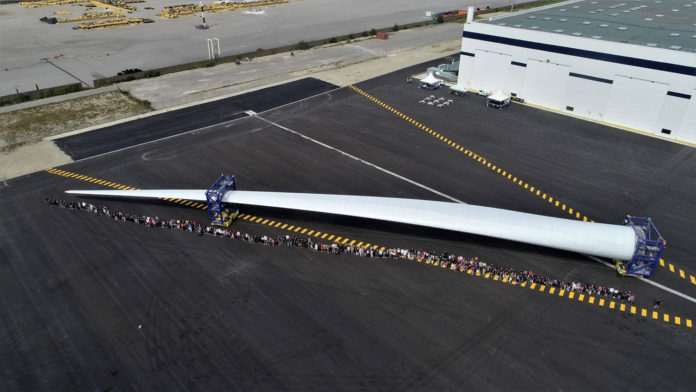Wind turbines generate electricity without using fossil fuels or producing particulate matter pollution, but they do create waste. Until recently, wind turbine blades were nearly impossible to recycle. Now, the energy companies, such as Siemens Gamesa, are trying to redesign wind energy so the giant components don’t end up in landfills.
In a similar effort, the ZEBRA (Zero wastE Blade ReseArch) consortium led by GE has manufactured the world’s largest thermoplastic blade, designed to serve as a full-scale example of a 100% recyclable wind turbine blade. The 62-meter recyclable wind turbine blade was designed and built by LM Wind Power using Arkema’s Elium resin, which is a thermoplastic resin well known for its recyclable properties.
The liquid thermoplastic resin is perfectly adapted for the manufacturing of large parts by resin infusion, combined with Owens Corning high-performance fabrics. The resulting composite material is said to deliver a similar level of performance to thermoset resins that are favored for their lightweight and durability. Elium based composite components can be recycled using an advanced method called chemical recycling that enables to fully depolymerize the resin, separate the fiber from the resin and recover a new virgin resin for reuse, acting as a proof-of-concept for a circular economy loop for the wind energy sector.
LM Wind Power will now start full-scale structural lifetime testing to verify the blade’s performance and its feasibility for future sustainable blade production. Once these tests are finished, the company will also validate the End Of Life recycling methods later in the year while also working on ways of recycling production waste.
“With this project, we are addressing two crucial industry challenges,” states John Korsgaard, Senior Director, Engineering Excellence, LM Wind Power. “On one hand, we are progressing on our Zero Waste Blades vision by preventing and recycling manufacturing waste. On the other, we are taking blade recyclability to a new level: the end-of-life thermoplastic composite blade material has a high value in itself and can be readily utilized in other industries as material compounds but can also be depolymerized and the resin reused in the production of new blades.”
The ZEBRA project was launched in September 2020 with the aim of demonstrating the technical, economic, and environmental relevance of thermoplastic wind turbine blades on a full scale, with an eco-design approach to facilitate recycling.
